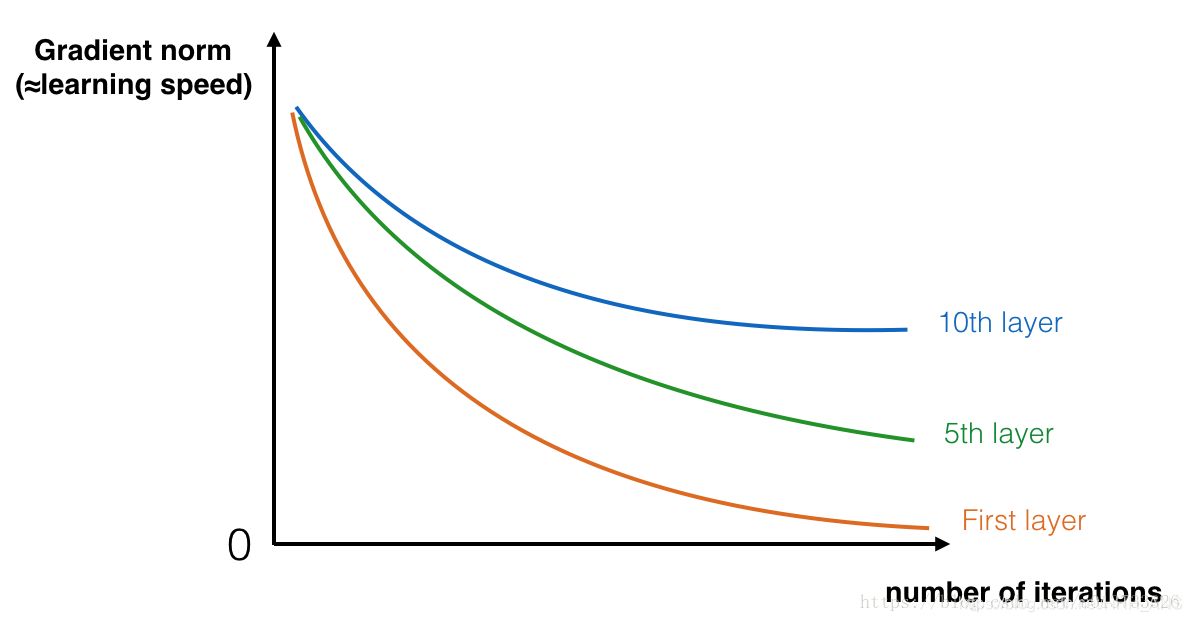機器學習筆記(十七):TensorFlow實戰九(經典卷積神經網路:ResNet)
1 - 引言
我們可以看到CNN經典模型的發展從
LeNet -5、AlexNet、VGG、再到Inception,模型的層數和複雜程度都有著明顯的提高,有些網路層數更是達到100多層。但是當神經網路的層數過高時,這些神經網路會變得更加難以訓練。
一個特別大的麻煩就在於訓練的時候會產生梯度消失,非常深的網路通常會有一個梯度訊號,該訊號會迅速的消退,從而使得梯度下降變得非常緩慢。更具體的說,在梯度下降的過程中,當你從最後一層回到第一層的時候,你在每個步驟上乘以權重矩陣,因此梯度值可以迅速的指數式地減少到0(在極少數的情況下會迅速增長,造成梯度爆炸)。
在訓練的過程中,你可能會看到開始幾層的梯度的大小(或範數)迅速下降到0,如下圖:

甚至訓練誤差比那些層數少的模型更大。

因此,所以為了解決這個問題,ResNet脫穎而出。
ResNet(Residual Neural Network)由微軟研究院的Kaiming He等四名華人提出,通過使用ResNet Unit成功訓練出了152層的神經網路,並在ILSVRC2015比賽中取得冠軍,在top5上的錯誤率為3.57%,同時引數量比VGGNet低,效果非常突出。ResNet的結構可以極快的加速神經網路的訓練,模型的準確率也有比較大的提升。同時ResNet的推廣性非常好,甚至可以直接用到InceptionNet網路中。

下面我們就來詳細的介紹一下ResNet網路
2 - ResNet網路結構
在殘差網路中,一個“捷徑(shortcut)”或者說“跳躍連線(skip connection)”允許梯度直接反向傳播到更淺的層,如下圖:

影象左邊是神經網路的主路,影象右邊是添加了一條捷徑的主路,通過這些殘差塊堆疊在一起,可以形成一個非常深的網路。
殘差網路的結構非常簡單,就是不斷的通過一組一組的殘差組連結,這是一個Resnet50的結構圖,不同的網路結構在不同的組之間會有不同數目的殘差模組,如下圖:

2.1 - 恆等塊
恆等塊是殘差網路使用的的標準塊,對應於輸入的啟用值(比如 )與輸出啟用值(比如 )具有相同的維度。為了具象化殘差塊的不同步驟,我們來看看下面的圖吧~


左側為正常了兩個卷積層,而右側在兩個卷積層前後做了直連,這個直連解釋殘差,左側的輸出為H(x)=F(x),而加入直連後的H(x)=F(x)+x,一個很簡單的改進,但是取得了非常優異的效果。
至於為什麼直連要跨越兩個卷積層,而不是一個?這個是實驗驗證的結果,在一個卷積層上加直連效能並沒有太大提升。
恆等快程式碼實現:
def _building_block_v1(inputs, filters, training, projection_shortcut, strides,
data_format):
"""A single block for ResNet v1, without a bottleneck.
Convolution then batch normalization then ReLU as described by:
Deep Residual Learning for Image Recognition
https://arxiv.org/pdf/1512.03385.pdf
by Kaiming He, Xiangyu Zhang, Shaoqing Ren, and Jian Sun, Dec 2015.
Args:
inputs: A tensor of size [batch, channels, height_in, width_in] or
[batch, height_in, width_in, channels] depending on data_format.
filters: The number of filters for the convolutions.
training: A Boolean for whether the model is in training or inference
mode. Needed for batch normalization.
projection_shortcut: The function to use for projection shortcuts
(typically a 1x1 convolution when downsampling the input).
strides: The block's stride. If greater than 1, this block will ultimately
downsample the input.
data_format: The input format ('channels_last' or 'channels_first').
Returns:
The output tensor of the block; shape should match inputs.
"""
shortcut = inputs
if projection_shortcut is not None:
shortcut = projection_shortcut(inputs)
shortcut = batch_norm(inputs=shortcut, training=training,
data_format=data_format)
inputs = conv2d_fixed_padding(
inputs=inputs, filters=filters, kernel_size=3, strides=strides,
data_format=data_format)
inputs = batch_norm(inputs, training, data_format)
inputs = tf.nn.relu(inputs)
inputs = conv2d_fixed_padding(
inputs=inputs, filters=filters, kernel_size=3, strides=1,
data_format=data_format)
inputs = batch_norm(inputs, training, data_format)
inputs += shortcut
inputs = tf.nn.relu(inputs)
return inputs
2.1 - 卷積塊
現在,殘差網路的卷積塊是另一種型別的殘差塊,它適用於輸入輸出的維度不一致的情況,它不同於上面的恆等塊,與之區別在於,捷徑中有一個CONV2D層,如下圖:


上面這樣圖能夠說明二者的區別,左側的通道數是64(它常出現在50層內的殘差結構中),右側的通道數是256(常出現在50層以上的殘差結構中),從右面的圖可以看到,bottleneck殘差模組將兩個33換成了11,33,11的形式,第一個11用來降通道,33用來在降通道的特徵上卷積,第二個11用於升通道。而引數的減少就是因為在第一個11將通道數降了下來。我們可以舉一個例子驗證一下:
假設樸素殘差模組與bottleneck殘差模組通道數都是256,那麼:
樸素殘差模組的引數個數:
bottleneck殘差模組的引數個數:
def _bottleneck_block_v1(inputs, filters, training, projection_shortcut,
strides, data_format):
"""A single block for ResNet v1, with a bottleneck.
Similar to _building_block_v1(), except using the "bottleneck" blocks
described in:
Convolution then batch normalization then ReLU as described by:
Deep Residual Learning for Image Recognition
https://arxiv.org/pdf/1512.03385.pdf
by Kaiming He, Xiangyu Zhang, Shaoqing Ren, and Jian Sun, Dec 2015.
Args:
inputs: A tensor of size [batch, channels, height_in, width_in] or
[batch, height_in, width_in, channels] depending on data_format.
filters: The number of filters for the convolutions.
training: A Boolean for whether the model is in training or inference
mode. Needed for batch normalization.
projection_shortcut: The function to use for projection shortcuts
(typically a 1x1 convolution when downsampling the input).
strides: The block's stride. If greater than 1, this block will ultimately
downsample the input.
data_format: The input format ('channels_last' or 'channels_first').
Returns:
The output tensor of the block; shape should match inputs.
"""
shortcut = inputs
if projection_shortcut is not None:
shortcut = projection_shortcut(inputs)
shortcut = batch_norm(inputs=shortcut, training=training,
data_format=data_format)
inputs = conv2d_fixed_padding(
inputs=inputs, filters=filters, kernel_size=1, strides=1,
data_format=data_format)
inputs = batch_norm(inputs, training, data_format)
inputs = tf.nn.relu(inputs)
inputs = conv2d_fixed_padding(
inputs=inputs, filters=filters, kernel_size=3, strides=strides,
data_format=data_format)
inputs = batch_norm(inputs, training, data_format)
inputs = tf.nn.relu(inputs)
inputs = conv2d_fixed_padding(
inputs=inputs, filters=4 * filters, kernel_size=1, strides=1,
data_format=data_format)
inputs = batch_norm(inputs, training, data_format)
inputs += shortcut
inputs = tf.nn.relu(inputs)
return inputs
